 By Chris Topham, Abtec Group.
By Chris Topham, Abtec Group.
Covering over 6,300 square metres, The Crystal, a sustainable cities initiative by Siemens, is a unique, all-electric building in the heart of London’s Green Enterprise District.
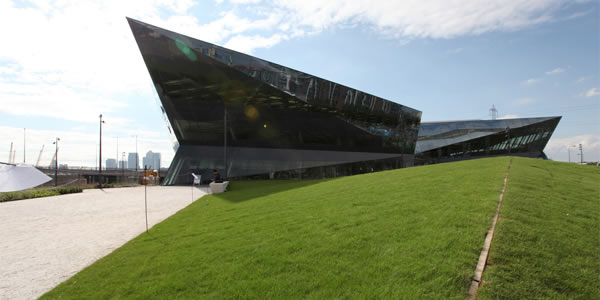
The building is both and exhibition centre and a working office for Siemens. It represents Siemens’ expertise in building the technology for sustainable cities and communities for the future. Using solar power and ground source heat pumps to generate its own energy, it has set the benchmark for sustainability. The building is the first to achieve the highest sustainable building accolades from the world’s two leading accreditation bodies, LEED and BREEAM.
Abtec Building Technologies was commissioned to manage the KNX infrastructure by Building Automation Solutions Ltd (BAS) in February 2012.
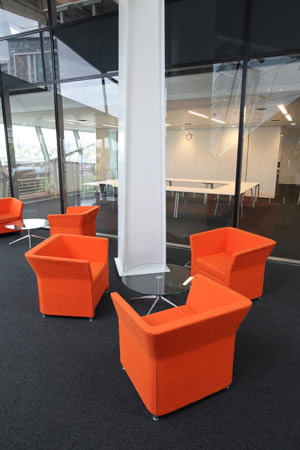
The Brief
Building management and control technologies were to play a vital part in reducing the building’s energy consumption. The Crystal has over 2,500 individual building control devices including window and blind actuators, HVAC controls, and lighting devices.
Dave Watkins, Commercial Director, Abtec Building Technologies, explains “The Crystal project was a very ambitious build. There are very few projects with this volume of connected building control devices.”

These devices create the highest levels of energy efficiency when connected and working together, but managing such a large number of devices would take expert IT and KNX knowledge, as well as good project management skills.
The Challenges
The project presented Abtec with several challenges. “We had three main challenges,” explains Watkins, “First, managing the deployment of KNX devices; second, converging the KNX and corporate IP network; and third, device interoperability.”
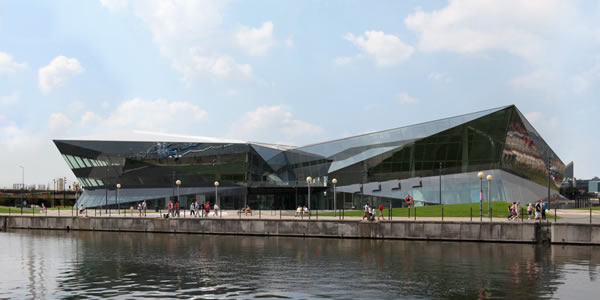
The database of connected devices includes:
• DALI lighting controllers
• HVAC controllers
– VAV
– CHB
– FCU
• Actuators
– Blinds
– Windows
– Roof vents
– Trench heating
• Wall switches
• Setpoint adjusters
• Exhibition lighting
• AV system interfaces
• Fire alarm interfaces
• Occupancy detectors
• Weather station
• Comfort sensors
Even though KNX operates using a decentralised infrastructure as each KNX device is embedded with intelligence, there was a need for the devices to integrate with a Building Management System (BMS). Devices would need to broadcast their state to, and receive commands from, the BMS, such as dimming the current lighting state by 20%.
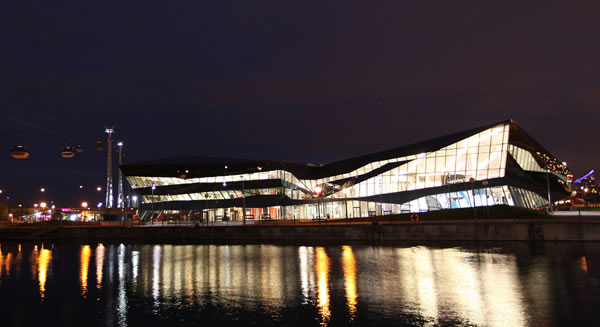
Challenge One: Controlling the Controllers
As with most large-build projects, there were many mechanical and electrical (M&E) subcontractors working on individual elements of the project. Watkins quickly realised that the traditional way of working, with each contractor installing their devices and then leaving the project, would cause problems. “The building controls and KNX infrastructure were at the centre of the M&E elements of the project. We needed to co-ordinate and manage how contractors connected to the KNX database, otherwise major delays could have occurred.”
Watkins and his team worked closely with the individual subcontractors. He got them to send their devices to Abtec’s laboratories in Leicestershire, before installation. Liaising with the subcontractors, the team pre-configured each device and allocated a KNX address. These devices were then sent to The Crystal, ready for installation.
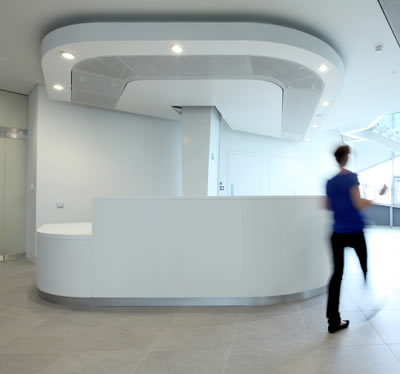
“There was a bit of reticence from the contractors to start with,” Watkins continue, “but once we’d explained that this method would save time and repeat visits to The Crystal they quickly bought into the idea.”
Abtec’s project management skills ensured that there was an industrious production line of activity. Phil Peer, Project Manager, Abtec Building Technologies, comments “We used ETS4 to configure and download the application program into each device. It was a huge task – by the launch we were on the 25th iteration of the project plan.”
This plan was executed effectively, and the devices were installed and commissioned on time. Andy Chandler, Technology Manager at Siemens UK, notes, “I was impressed with the way the team put the KNX database at the heart of the project. This saved precious time and resource.”
Challenge Two: Networking Success
Another unusual aspect of the project was the connection between the KNX devices and the BMS. In a traditional KNX environment, the building would have a hardwired KNX network that would connect to a discrete, dedicated IP network. In this project, the KNX infrastructure would share Siemens’ corporate IP network.
“It’s a configuration that is becoming increasingly popular,” Watkins explains, “We are seeing more KNX projects utilise the client’s IP network. It’s definitely the way forward as it cuts costs for both the contractor and end user.”
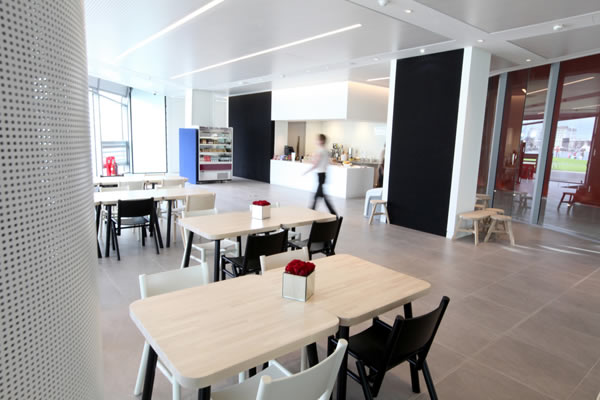
Converging those networks would create considerable challenges for many KNX integrators, but Abtec has a unique advantage in that the company’s sister organisation, Abtec Network Systems, is an IP networking specialist and often works with KNX integrators. Its recent projects include deploying the IT infrastructure for National Grid’s new, award-winning offices.
“The biggest risk in using the corporate network was KNX itself. We didn’t want it multicasting telegrams over the IP network as this would clog up the IP network, causing chaos” says Watkins.
Detailed network control was required, so, using its Cisco expertise, the Abtec Network Systems’ team devised a way of partitioning Siemens’ corporate LAN. Segmenting the LAN, using the Cisco VLAN Trunking Protocol, would mean that both sets of data, KNX and corporate, would travel over the network without interference. It’s as if the virtual LANs (VLANs) were physically separate networks.
Abtec Network Systems worked closely with Atos UK & Ireland, which manages Siemens’ data network. Giving Atos the necessary configuration details, it directed Atos to create the VLANs, as creating VLANs was the most secure way to tackle this issue.
Challenge Three: Device and Network Interoperability
The final challenge was the large amount of data that was required to flow from one protocol to another. Ensuring that these discrete protocols communicate with each other was a challenge that Duncan Greene, Abtec KNX Project Engineer, tackled.
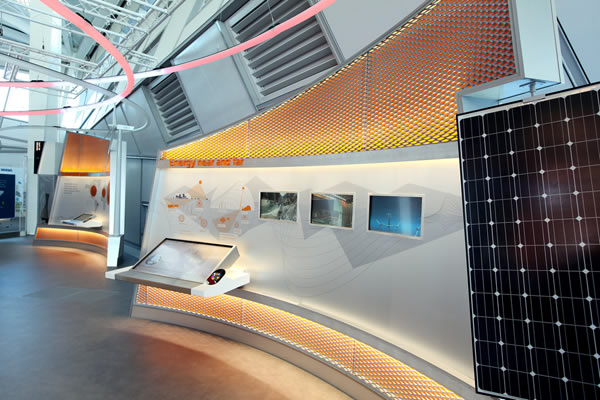
The device interoperability challenge is best exemplified with The Crystal’s boardroom. The 150m2 room contains 117 DALI LED and fluorescent light fittings, and five floor-ascending blinds. The KNX database for this room alone was more complex than many typical projects. The real challenge came when Abtec learnt how the client wanted to control the room’s lighting and blinds. First, via an IP touchscreen situated in the boardroom, and second, via a smartphone-compatible website that would be accessible wirelessly from the corporate network.
“This presented some interesting issues,” explains Greene, “The touchscreen and smartphones are IP devices, the blinds are KNX and the lighting is DALI over KNX. I had to make sure that they could communicate with each other. The second issue was that the boardroom is one room in a sophisticated infrastructure. I needed absolute control of the network as I didn’t want to overload the KNX bus.”
To add to this complexity the touchscreen would display outdoor temperature and humidity levels. This information would be supplied to the device through a BACnet network. The potential security risk here is that both the corporate and BMS network could be open to abuse, if configured incorrectly.
Greene instigated a workshop with Andreas Schirm of Siemens Switzerland Ltd, and BAS. Together they could test the interoperability between Schirm’s touchscreen, BAS’ BACnet IP network and Abtec’s KNX IP network. At Abtec’s laboratories, Greene built a series of VLAN networks, replicating the infrastructure at The Crystal. After rigorously testing several ideas, Greene was satisfied that he had found an acceptable solution.
“The start of this solution was installing two virtual network interface points into the touchscreen,” says Greene. Creating several VLANs for KNX and BACnet, using Cisco routers, would enable traffic to connect with the touchscreen securely. The touchscreen could interact with each protocol independently, mitigating some of the security risks. “I tested the networks, checking for penetration opportunities and points of failure, paying close attention to wireless access points. With appropriate network security measures, I managed to harden the networks, locking them down with no detrimental effect to the traffic on the networks.”
Greene’s testing enabled Abtec to create a blueprint for the IP and KNX network design, which Atos duly implemented. Siemens’ employees now have full control over the environment in the boardroom, which should lead to more productive meetings.

“The Crystal is a showcase for new technologies,” comments Andreas Schirm. “I was impressed with the way that Abtec tackled the challenges that these new technologies produced. My expertise is in KNX, not IP devices. I was really impressed with Duncan’s KNX and IP knowledge and the way he broke the issue down into the component parts and communicated this effectively. Duncan helped us solve the problem faster.”
Conclusion
The team completed its KNX integration work successfully for the opening on 19th September 2012. The building has since gone on to win numerous awards, including the prized British Council of Offices National Innovation Award. It has also achieved the highest international sustainability credentials for a building, LEED Platinum and BREEAM Outstanding. This makes The Crystal one of the most sustainable buildings in the world.
In this project Abtec demonstrated broad skills in several protocol areas, namely KNX, IP and DALI. These skills, and the team’s tenacity, helped it overcome considerable challenges. Abtec also clearly demonstrated that it can work on large-scale projects with many subcontractors.
As Andy Chandler, Technology Manager Siemens UK, comments, “Abtec’s KNX, DALI and IT skills made the deployment much smoother. The team demonstrated great leadership qualities, overcoming a number of difficult challenges throughout the project. Working with Abtec has been a pleasure. The team’s project management skills and significant KNX, DALI and IP networking expertise make Abtec easy to recommend for other projects.”
Equipment List
Crabtree:
Push Button Platinum 2g (1-fold) 7172
Push Button Platinum 4g (2-fold) 7174
Push Button Platinum 6g (3-fold) 7176
Siemens:
Power supply unit N 125/21 (230V/640mA)
Line backbone coupler N 140/03
KNX/DALI Gateway N 141/02
IP-Router N 146/02
Push button interface UP 220/21
Push button 1-fold UP 221 DELTA i-system
Motion Detector AP 251
Weather Station GPS AP 257/22
Presence detector – brightness sensor UP 258/E11
Presence detector – constant light UP258/E21
Motion Detector UP 258 Delta i-system
Scenes-/Event Controller N 305
Combi Sunblind Actuator N 501
Venetian blind actuator N 523/04
Switching Actuator UP 562/31
Switching actuator N 567/01, (8 Amp)
Text display UP 587/01
Siemens HVAC:
AQR2570N Flush Mount Sensor
PX KNX (S-Mode)
RMS705B Switching and
Monitoring Unit
WindowMaster A/S:
WEA11M
Chris Topham is Head of Marketing for the Abtec Group. The Abtec Group includes Abtec Building Technologies Ltd which provides technologies that enable organisations to reduce the running costs of their buildings, and Abtec Network Systems Ltd which helps UK businesses get more from their IT budget.











